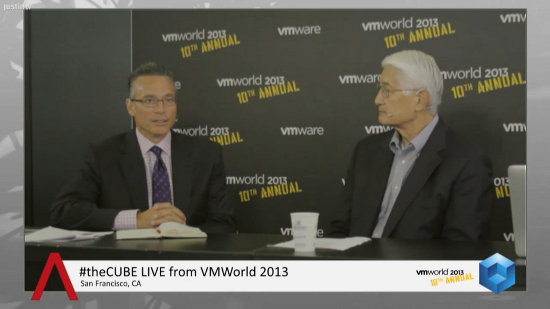 NEWS
NEWS
 NEWS
NEWS
 NEWS
NEWS
Hu Yoshida, VP and CTO, Hitachi Data Systems, discussed his company’s relationship with VMware and software-defined data center trends with theCUBE co-hosts John Furrier and Dave Vellante, live at VMWorld 2013.
![]()
“23,000 people, it’s quite amazing, it shows the impact of virtualizaiton,” Yoshida said, commenting on this year’s edition of VMWorld. Virtualization is where the industry has to go. “We can make changes to the technology without disrupting the applications.
“We’ve had an over ten-year relationship with VMware,” Hitachi being one of the early adopters. “We are also an early design partner with them, we’re not just looking for things to integrate with, we’re really involved with the design with them,” recalls Yoshida.
Virtualization stressed storage a great deal, and many of the provided integrations were designed to deal with spinning disk, and now flash made a play, Vellante pointed out.
“The hard disk technology has slowed down,” Yoshida explained. Everything done at capacity level, disk is making it slower and slower. “Flash will be required to be the top tier and provide top performance,” while disk maintains capacity. It requires automation, virtualizations, the software defined data center.
Asked to explain the unified compute platform, Yoshida explained that unified compute was “taking server, storage and network, be able to integrate them, and be able to present them through a software defined interface. It helped us be more integrated with the software defined data center.” The platform allows to manage provision, and everything else through the vCenter interface. “We’re the most closely integrated vendor,” he added.
Watch the full interview below:
Asked how the software-defined data center disrupted IT professionals’ activity, Yoshida said it actually “simplifies the environment, every new function that comes in, they don’t have to deep dive into the element. Using our APIs, they are able to add functions without going deep-dive.”
As far as the effect on the hardware business is concerned, the software-defined datacenter “does not mean we have commodity hardware,” said Yoshida. “The infrastructure has to be much more smarter to enable that. Intelligent hardware supports the software defined data center.” Hardware that is less differentiated is going to be more important moving forward. “This integration between VMware and the hardware will really create the software defined data center.”
Asked what tech trends excited him, Yoshida said it was the whole approach about the information cloud. “As VMware moves to the cloud, as we are able to share resources, applications across the public and private cloud, that will be transformational.”
Support our open free content by sharing and engaging with our content and community.
Where Technology Leaders Connect, Share Intelligence & Create Opportunities
SiliconANGLE Media is a recognized leader in digital media innovation serving innovative audiences and brands, bringing together cutting-edge technology, influential content, strategic insights and real-time audience engagement. As the parent company of SiliconANGLE, theCUBE Network, theCUBE Research, CUBE365, theCUBE AI and theCUBE SuperStudios — such as those established in Silicon Valley and the New York Stock Exchange (NYSE) — SiliconANGLE Media operates at the intersection of media, technology, and AI. .
Founded by tech visionaries John Furrier and Dave Vellante, SiliconANGLE Media has built a powerful ecosystem of industry-leading digital media brands, with a reach of 15+ million elite tech professionals. The company’s new, proprietary theCUBE AI Video cloud is breaking ground in audience interaction, leveraging theCUBEai.com neural network to help technology companies make data-driven decisions and stay at the forefront of industry conversations.